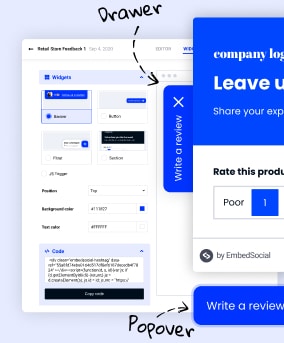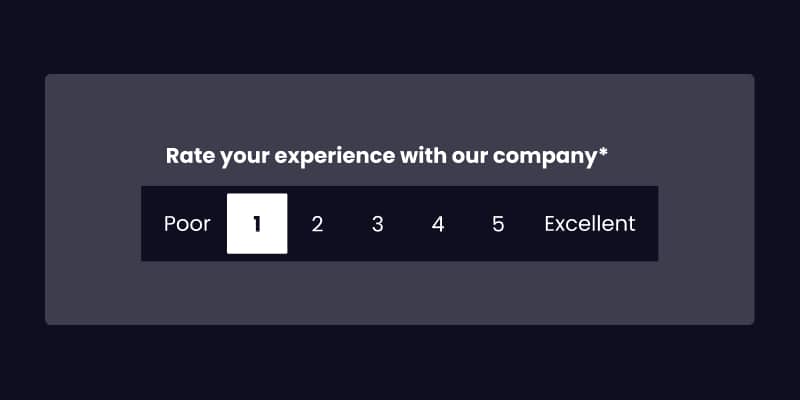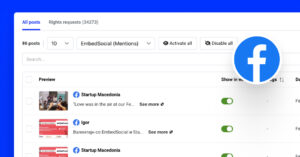Conducting a successful survey with a high response rate is really hard.
And defining the right questions for your survey is the first step.
Lately, this activity is becoming much easier as there are form builders like EmbedForms that provide free form templates with pre-defined questions to help you get started with the creation of your survey.
In this post, we will show you what types of survey questions you can ask and a pre-built list of questions you can use right now.
So without further ado, let’s dive in.

Build all your web forms for free
EmbedForms is the only form builder you will ever need to capture web leads, create surveys, or collect feedback on your website.
All PRO features | Cancel any time.
What makes a good survey question?
A good survey question should give you accurate and unbiased information for the topic you seek information.
For small business owners, this means that good survey questions should give you clear and truthful answers about how customers feel about your business.
For example, you might want to understand how customers feel about your website usability, and the pricing of your product/service, or perhaps you want to learn what keeps them from buying your new product.

To find this out, you need accurately formulated questions that will give you the correct answers. The survey data will later help you understand which aspects of your business might need improvement in order to meet your customer needs.
At the very least, a good survey question is clearly worded and does not lead respondents to give incorrect and false customer feedback.
How many questions make a good survey?
The answer to this question largely depends on the purpose of the survey. However, shorter surveys tend to have higher response rates since respondents need a shorter time to fill them out.
Usually, customer satisfaction surveys do not take more than 5 minutes out of their respondents’ time, so this would mean that they contain around ten questions.
A well-defined goal will help you identify the right questions and discard the unnecessary ones.
1. Open-ended vs. closed-ended questions

The difference between closed-ended and open-ended questions is whether the respondents are offered answers to choose from or are free to write whatever they want.
That being said, the answers to open-ended questions come in the form of paragraphs or text boxes, so there are no limitations in your respondents’ answers.
On the other hand, questions that include answers in advance belong under the umbrella of closed-ended questions.
This type of question comes in multiple forms like:
- Multiple-choice questions
- Rating scale
- Dropdown menu
- Image choice questions
Which one should you use?
Use closed-ended questions when you want a quick and straightforward survey.
Since these types of questions offer answers in advance, the surveys are much easier and faster to answer.
Closed-ended questions are the way to go if you want to gather quantitative data and segment the respondents.
However, it would help if you are careful when writing the answers. You shouldn’t miss the ones that are expected to be offered.
Open-ended questions offer the researcher an opportunity to gain valuable and unique insights.
You should use open-ended questions because they can give you answers you might not expect.
This is important because it gives you a different perspective on the issue you are researching.
Nevertheless, these types of questions come with a bit of a setback.
They are somewhat difficult to analyze and interpret the data that come from them.
Still, if you want to proceed with these types of questions or choose some of the closed-ended ones, we have explained them all in the points that follow.
However, we recommend using a combination of both groups to gather insightful and valuable information from your audience.
2. Paragraphs

As mentioned earlier, the answers to open-ended survey questions come in the form of paragraphs, text boxes, short-text, or long-text.
This means that most online survey builders use one of these names to mark the option for open-ended questions.
We use open-ended questions to give the respondents the freedom to write their answers in their own words.
Open-ended questions are helpful when you want to gather a bunch of different opinions and experiences.
They are great for increasing customer satisfaction when surveying your business.
On the flip side, you should be mindful when using open-ended questions.
Since they require more in-depth answers, they also require more time to answer them. Therefore, the response rate can be lower.
Furthermore, you should expect difficulty when analyzing the survey results. You will receive a variety of different answers that can be challenging to interpret.
3. Multiple-choice questions

Multiple choice questions are primarily used when it comes to surveys, and they belong to closed-ended questions.
In these types of questions, the respondents are asked to choose one or more answers that you have previously listed.
The dropdown menu, dichotomous questions (yes/no questions), and rating scales all belong in the group of multiple-choice questions.
These questions are straightforward and precise, and they don’t take any longer than a few seconds to be answered.
That leads us to the first benefit of using multiple-choice questions; they are short, intuitive, and easy to understand.
And most importantly, the survey responses are easy to analyze.
Multiple-choice questions come in many formats. One of them is the single-answer format.
The answers are presented in small circles called radio buttons, and the respondent needs to click only one of the options.
Another format is the check-box format, where the respondent is allowed to select more than one answer.
Even though multiple-choice questions are the most common among surveys, you still need to keep in mind a few disadvantages.
They are easy to answer but complex to create.
Take into account that you need to have a deep understanding of the topic you explore to offer answer options that will give you insightful data.
4. Dichotomous questions

Dichotomous questions are questions that offer two opposite answers. When a question has yes/no answers, agree/disagree, or true/false answer options, it is a dichotomous question.
Here is an example:
“Did you find what you were looking for today?” (Yes/No)
“Did the customer support team manage to resolve all your product-related issues?” (Yes/No)
It is most practical to embed these mini-surveys or forms as feedback widgets on a specific page. For example, you can implement a yes/no form on a help page and ask your readers:
- “Did this answer your question?”
And offer them a yes/no answer.
It is essential to be careful with this type of question and ask them when there really is room for respondents to decide between two extremes.
5. Dropdown selector
The dropdown menu belongs to the closed-ended question group since it has predefined response options.
In online questionnaires, respondents can answer dropdown menus once they click the down arrow.
You’ve probably come across this type of survey question when you’ve answered demographic questions like age, and nationality.
Depending on the survey tool, most dropdown menus are scrollable when answered from a phone, making them fast and easy to answer.
6. Rating scale

The NPS (net promoter score) is the best example of a rating scale question.
Rating scales like NPS are used to measure customer satisfaction and customer loyalty.
In these types of questions (sometimes referred to as ordinal questions ), the answer is presented with a scale from 0-10.
The respondents select one number from the scale that best describes their answer.
There are a few types of rating scales like numeric scale, Likert scale, or star rating scale.
Rating scales are both used for quantitative and qualitative data.
The pro thing about using rating scales is that they are simple to understand and answer, plus the gathered data is easy to analyze and interpret.
On the other hand, the data you’ll receive is limited. You get the rating, but there is no information about the reason behind the score.
Getting started with NPS
7. Likert scale questions

Likert scale questions are one of the most popular ranking questions used to measure the level of agreement, frequency, quality, or importance of a product/service.
Likert scale questions can be formed as a statement for example:
“The website is easy and understandable to use”
Respondents are then given a scale of answers ranging from strongly agree to strongly disagree.
Researchers can also ask Likert questions in the form of a question for example:
“How likely is it that you will buy from us again?”
Respondents can again choose an answer from the point scale that ranges from very likely to very unlikely.
8. Image upload questions

Image upload questions allow the survey-takers to upload an image to your survey.
It’s a great way of showing social proof to customers online.
Plus, it adds up to a better customer experience when users can see your product’s realistic image.
Additionally, you gain information about how your customers use the product.
The pros of using image upload questions in your survey are adding credibility and saving your respondents time for writing down long answers.
Survey question examples

Deciding which questions to use mostly depends on what you want to research. That is, from the goal you want to achieve with the survey.
Of course, the questions also depend on the nature of the business itself.
However, below we made a list of survey questions examples that you can include in any survey.
Open-ended questions examples
- Is there anything that we can do to improve your experience with us?
- What stopped you from finalizing your purchase today?
- Is there any information missing from our website?
- What other information would you like to see on this page?
- What other products would you like to see us offer?
Multiple-choice questions examples
- How did you find out about us?
- Why did you choose us?
- Did you find enough product details?
- Which features have you been using the most?
- How many times have you used our services?
Dichotomous questions examples
- Did you find what you were searching for?
- Did you receive your product on time?
- Would you buy something from us again?
- Are you going to purchase any of our products again?
- Did you feel the staff was welcoming and friendly?
Rating scale question examples
- On a 1-10 scale, how would you rate our customer service?
- On a 1-10 scale, how would you rate the product quality?
- How would you rate the value for the money of the product?
- On a 1-10 scale, how would you rate our response time?
- Would you recommend us to a friend or a colleague?
Likert scale questions examples
- How safe did you feel while sharing your card details?
- How likely is it that you would buy something from us again?
- How satisfied are you with the service and approach of the staff?
- How often do you purchase from our store?
- How would you rate the quality of the product?
Tips for writing good survey questions

In today’s modern world, survey templates full of different questions relevant to your topic are just one click away from you.
There is no need for you to invest your time in creating one from scratch when you can have a professional-looking survey in minutes using EmbedForms.
However, if you are still curious about writing effective survey questions, here are 3 simple steps you should follow:
- Be direct. Use clear and understanding expressions that can be comprehensible by everyone.
- Don’t be biased. Avoid writing questions that lead the respondent to a particular answer. Try to construct as specific questions as possible.
- Avoid writing double-barreled questions. Ask one thing per question to avoid confusion.
- Sensitive questions. Keep in mind that some questions like personal life, religion, etc., can be seen as sensitive. Respondents may not answer these questions, or they can answer them untruthfully.
- Be mindful of the question order. It may seem simple, but it can be easily mistaken. A logical schedule of questions means asking the most important questions at the beginning and the most unimportant ones at the end.
FAQ to write the best survey questions
A survey question that forces respondents to choose from a fixed set of options is called a closed-ended question. This type of question survey can be advantageous because it:
Allows you to collect data that can be easily analyzed and compared
Reduces the chances of ambiguity or misinterpretation
Can help ensure that all respondents have unified responses
An example of an open-ended survey question would be: “What are your thoughts on the new company policy?” This type of survey question allows respondents to answer in their own words, which can provide valuable insights that closed-ended questions may not capture.
When writing survey questions, it is important to avoid bias and ambiguity, be understandable for the responder, and be able to answer the question easily. A good survey question is concise, clear, and easy to answer.
A leading survey question is one that suggests a particular answer or response. For example, a survey question that asks “Don’t you agree that this new company policy is great?” leads to a YES answer.
A double-barreled survey question is one that asks two questions in one, or where the answer to one part of the question affects the answer to the other part. For example, a survey question that asks “Do you like our new company policy and do you think it’s great?” is double-barreled.
A loaded survey question is one that uses loaded language to influence the respondent’s answer. For example, a survey question that asks “Don’t you think this new company policy is terrible?” is loaded with a NO answer.
A survey question can be biased in its wording, tone, or the way the question is asked. For example, a survey question that asks “How often do you find our company’s products to be satisfactory?” is biased toward a positive answer.
It depends on the type of survey and the purpose of the survey. A survey can have as few as one question or more than 100 questions.
A survey question can be too vague if it does not provide enough information for the respondent to answer. For example, a survey question that asks ‘How are you today?’ is too vague.
To make sure your survey questions are clear and concise, use simple language and avoid jargon. Also, be sure to proofread your questions before sending out the survey.
Survey questions usually start with a question word such as ‘What,’ ‘How,’ or ‘Why.’ For example, a survey question could be ‘What is your favorite color?’
The most common survey questions are:
How often do you do X?
What is your opinion on X?
Would you recommend X to a friend?
Did you find X easy or difficult to use?
What did you think of X?
Key takeaways
We’ve gone through different types of survey questions, and we saw that each one has its pros and cons.
The most important thing when choosing a type of survey question is to know when to use it and what for.
Once you learn the best application for each of these questions, putting them into practice will give you great results.
And the best, using pre-defined templates to create forms is a fast way to start building your next survey form.

Build all your web forms for free
EmbedForms is the only form builder you will ever need to capture web leads, create surveys, or collect feedback on your website.
All PRO features | Cancel any time.






